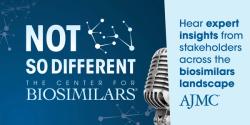© 2025 MJH Life Sciences™ and The Center for Biosimilars - Biosimilars, Health Economics & Insights. All rights reserved.
BioRationality: The FDA Sets Sights on Removing Clinical Efficacy Studies for Biosimilars
A New Era Dawns for Biosimilar Development
Fifteen years have passed since the Biologics Price Competition and Innovation Act (BPCIA) transformed the biosimilar landscape. Today, we are at a crucial point: the FDA has finally removed clinical efficacy studies for all biosimilar molecules, marking the most significant regulatory change in biosimilars' history.
On October 29, 2025, FDA Commissioner Marty Makary, MD, MPH, confirmed at GRxBiosims2025 that “we'll be releasing new draft guidance today to remove the comparative study requirement for biosimilar applications. It should shave off 3-4 years from the approval process.” I had recently obtained these waivers for products that I am personally working with, but this is the first time the FDA has announced a commitment to extending the waiver to all biosimilars.
One reason for the FDA possibly doing this now is to reduce barriers to new biosimilar filings. The industry's outdated playbook—those McKinsey estimates suggesting $100 to $300 million per biosimilar approval—belongs in the archives.1 With strategic regulatory reforms now in place, developers can realistically target development costs as low as $10 million.
Fifteen Years of Advocacy: Victories Achieved
My journey advocating for science-based biosimilar regulation spans over 40 peer-reviewed publications, 12 citizen petitions, and countless meetings with FDA scientists. The principle driving these efforts has never wavered: regulatory decisions must be grounded in scientific rationality, not tradition.
Major Regulatory Wins to Date:
- Tier-based analytical testing — ELIMINATED
- Animal toxicology studies — REMOVED
- Immunogenicity testing — WAIVED for insulin (precedent for all molecules)
- Redundant interchangeability studies — ABOLISHED
- Non-US reference products — NOW ACCEPTED (when identical)
- Clinical efficacy for cytokines — WAIVED
- Clinical efficacy for antibodies — JUST APPROVED FOR WAIVER
The Unfinished Agenda: Four Critical Reforms
While we celebrate these victories, our work continues. I'm actively collaborating with the US Senate and White House to advance four game-changing reforms:
1. Standardized Analytical Testing Through USP or Approved Labs
The FDA's historical opposition to USP biological monographs has created an unnecessary burden: developers must procure 10 reference product lots—a costly and complex endeavor. My solution? Enable US Pharmacopeia or FDA-approved commercial laboratories to establish standardized product release specifications and validated testing methods. This ensures consistency across all biosimilar products while dramatically reducing development barriers.2
2. Eliminating Redundant Pharmacokinetic Studies
For intravenous products, pharmacokinetic studies offer zero scientific value, in my opinion. While some utility exists for controlled-release formulations, such as certain insulins, mandating these studies for all products constitutes unnecessary human exposure. I've petitioned the FDA to recognize this ethical consideration and eliminate these scientifically unjustified requirements.
3. Clarifying Immunogenicity Testing Requirements
The science is unequivocal: when analytical assessments match, immunogenicity testing adds no value beyond data manufacturers have already collected. All immunogenic differences stem from analytical variations. The FDA must explicitly state this principle, acknowledging that immunogenicity testing in small populations cannot predict causality in broader patient groups.
4. Mandating Point-of-Use Filtration
Here's a simple innovation that could transform the safety of biological drugs: requiring 0.2-micron filtration at the point of use. Larger aggregates—the primary culprits in immunogenicity—can form during storage and transportation. While recognized for its use in erythropoietin, this preventive measure should be standard for all biological drugs. It's a low-cost, high-impact safety enhancement that's inexplicably absent from current requirements.
Breaking the Patent Barrier
The US Patent and Trademark Office (USPTO)'s past resistance to addressing double-patenting—a uniquely American obstacle—continues hampering biosimilar entry.3 Despite withdrawing supportive Senate legislation under pressure from the pharmaceutical industry, legal pathways remain. I've provided the new FDA Commissioner with a detailed legal framework leveraging HHS Secretary authorities under existing legislation. With John A. Squires recently appointed as USPTO Director, renewed dialogue may yield progress.
The Vision: A Transformed Biosimilar Market
These reforms will fundamentally reshape the biosimilar landscape:
- Development costs will mirror abbreviated new drug application filings—simpler than even 505(b)(2) applications
- Market access for the over 100 remaining biological molecules currently without biosimilar competition
- Pricing will reflect actual competition, benefiting patients and health care systems
- Industry dynamics will shift from significant large pharma dominance to diverse, innovative developers
- Education barriers will dissolve as biosimilar adoption becomes routine, not exceptional
The Bottom Line
We're witnessing the transformation of biosimilar development from an exclusive, high-stakes game to an accessible, science-driven process. The elimination of clinical efficacy studies represents not just regulatory evolution but a triumph of scientific reasoning over institutional inertia.
For stakeholders navigating this new landscape, the message is clear: embrace the scientific paradigm, abandon outdated assumptions, and prepare for a market where biosimilar development is measured in months, not years, and millions, not hundreds of millions of dollars.
The final frontiers are within reach. The question isn't whether these changes will come—it's how quickly we can implement them.
For more insights on biosimilar regulation and development strategies, contact Dr. Sarfaraz K. Niazi at sniazi3@uic.edu
References
1. Fontanillo M, Körs B, Monnard A. Three imperatives for R&D in biosimilars. McKinsey & Company. August 19, 2022. Accessed October 29, 2025. https://www.mckinsey.com/industries/life-sciences/our-insights/three-imperatives-for-r-and-d-in-biosimilars
2. Niazi, SK. Advice to the US FDA to allow US Pharmacopeia to create biological product specifications (BPS) to remove side-by-side analytical comparisons of biosimilars with reference products. Pharmaceutics. 2024;16:1013. doi:10.3390/pharmaceutics16081013
3. Pan FY, Chaemsupaphan T, Cartwright S, Leong R. Self-injection satisfaction and safety of CT-P17 (Yuflyma), a high-concentration adalimumab biosimilar, in patients with Crohn’s disease: a cross-sectional study. JGH Open. 2025;9(4):e70230. doi:10.1007/s40259-024-00632-6



